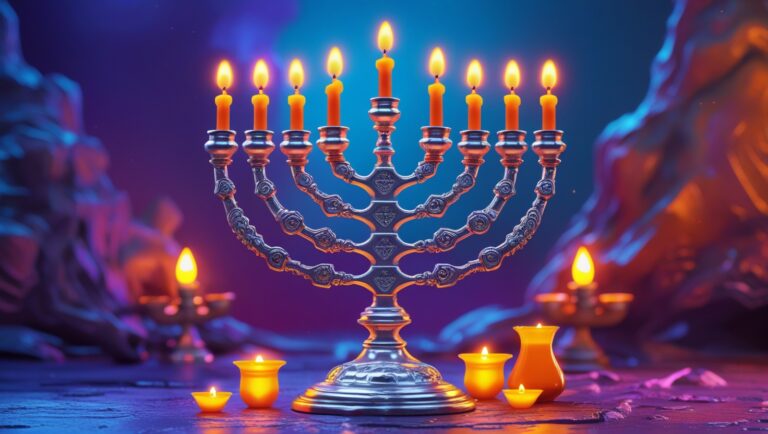Transcription: Reincarnation (Gilgul) is one of the main principles of Kabbalah.
However, many other spiritual traditions also teach about it. This is in fact a very universal concept and is literally one of the most convenient way of explaining why certain things happen in our lives. A person who made another lose his hand may come back and lose his hand as well. Similarly, one who was once rich can reincarnate as poor because he didn’t give charity enough so he has to experience that pain, and vice versa.
It could also be that someone killed another person in a previous lifetime and he may need to die in the next lifetime by that person.
Transcription for the Webinar on Reincarnation
Rebbe Nachman writes in Likutey Moharan that the reason why we see Tzadikim who are rich in his generation is because they were once poor, therefore they don’t need to suffer with money. And the Mishnah in Pirkei Avot says “Whoever fulfills the Torah in poverty will fulfill it in riches”. There are many other verses that we can understand in light of the Gilgulim.
The main book we learn about the mechanisms of reincarnation is Shaar Hagilgulim written of course by Rabbi Chaim Vital as he learned these secrets from the holy Arizal R’ Yitzhak Luria. This is a very complex and deep book where Rabbi Chaim Vital gives a very thorough analysis of how reincarnation works. It is of course beyond the scope of one lesson so we will go over some of the main points.
The book begins by saying that a person is in reality his soul, not his body, and that there are 5 levels of the soul: Nefesh, Ruach, Neshama, Chaya and Yechida. Each of them come from a specific spiritual world, the Nefesh from Assiyah, the Ruach from Yetzirah, the Neshama from Beriyah, the Chaya from Atzilut (he doesn’t mention the source of Yechida here).
Everyone starts with the Nefesh from the world of Assiyah. However, as we know each of the 4 worlds have 5 Partzufim which are systems of Sephirot. They are Nukva, Zeir Anpin, Aba and Imma and Arich. So far so good?
Ok, so to complicate a little more, every Partzuf is divided into 10 Sephirot as well. Once he rectifies the 10 Sephirot within his specific root Partzuf then he goes to the next Partzuf. Once he finishes all the 5 Partzufim of Assiyah, then he gets his Ruach from Yetzirah. And Yetzirah is higher than the entirety of all of Assiyah.
Generally, Rav Chaim Vital writes that it’s very difficult for a person to rectify the Nefesh in one go and this is why we have reincarnation. Since the Nefesh comes from Assiyah, and this is the world closest to the realm of evil, it can take a lifetime to do the job.
The Nefesh is the one that most needs rectification as it is influenced by the Sitra Achra to sin. But it itself is pure and holy. Because of that, Hashem elevates a person’s nefesh from Sephira to Sephira until he reaches the Keter of Assiyah. So it goes from Malkhut of Assiyah, to Yesod, to Hod… until Keter.
The problem is compounded by the fact that he has to rectify ALL the sins of his particular soul-root in order to move up to a higher world, even those he didn’t commit. Hashem in his infinite mercy gives good people plenty of opportunity to rectify their shortcomings. However, for the wicked, they are given only 3 tries and this is based on a certain Pasuk:
הֶן כָּל אֵלֶּה יִפְעַל אֵל פַּעֲמַיִם שָׁלוֹשׁ עִם גָּבֶר
When a person finally reaches the world of Yetzirah he receives his Ruach and then each Sephira he goes up, he receives a new Ruach because Yetzirah is further away from the realm of the Sitra Achra than Assiyah. This is by the one, one of the reasons why a person can get the Ruach of a certain Tzadik by performing certain Mitzvot the way he did or going to his Kever (grave). The final level the Tzadik reaches, that’s the level that’s in the Gan Eden Elyon (higher Gan Eden). The lower levels are available for people to get if they deserve.
Now, there are 2 types of reincarnation
- Full reincarnation (Gilgul) – When a soul gets in the person from birth and leaves only after death. They get both the reward as well as the punishment. You can have up to 3 of these + you.
- Yibur (Pregnancy) – When a soul joins the living person during his or her lifetime. It can happen when you follow a certain Tzadik and fulfils his words or customs. In this case he may then join you to help you get closer to God. However, he may leave if he sees the person is about to sin because he’s not bound by that person. In this case, he receives part of the reward but not the punishment. However, Yibur may also happen when the soul of a wicked person sticks to a living being and influences them. This is why it’s important to not go near the grave of a wicked person as we spoke before.
In Shaar Hagilgulim, the Arizal teaches us many fascinating Gilgul.. One of the most striking is that of Yochanan Kohen Gadol (the high priest) who had the huge merit of preparing 2 ashes of the red heifer. At the end of his life, he abandoned the Jewish tradition and became a Tzeduki (Sadducean, those that reject the Rabinic Oral Tradition). The Arizal teaches that Yochanan was reincarnated in R’ Elazar Ben Durdaya. This is a very popular story in the Talmud. R’ Elazar Ben Durdaya went through all the harlots in the world. He was probably not called Rabbi then.
A bat kol announced “Rabbi Elazar Ben Durdaya Mezuman Lechayey HaOlam HaBah” (Translation). Rebi cried and said: There are some who acquire the Olam HaBa after many years, and there are those that acquire it in one moment. Not only are those who do Teshuva accepted, but they are called a Rabbi.
Some other notable examples: Zohar mentiones that Moshe Rabbenu who was a huge soul is the Gilgul of Hevel (Abel) while Yitro, his father in law is the Gilgul of Cain. He did Teshuva by giving his daughter Tzipporah to Moshe. What happened was that our sages teach in the Midrash that both Cain and Hevel were born with twins, Cain with 2 other women and Hevel with 3.
I know this sounds strange but this is by the way, the source of the “soulmates” expression, a soul that is literally from your same soul-root. Back before the Torah was given, this type of relationship could happen but now since the souls were mixed up in different bodies, it’s forbidden.
(The world changed a lot)
In the Zohar, we learn that there are 4 Kingdoms: Inanimate, vegetable, animal and humans. Rabbi Chaim Vital teaches that depending on the sins of a person, certain parts of his soul may reincarnate in different realms. The reason is because each of us also has these 4 aspects within us. When a person is reincarnated in either of these kingdoms, and someone else does a Mitzvah with him, then he’s rectified. This is one of the reasons why we used all these elements in the Holy Temple.
Nowadays, when we eat on Shabbat, for example, it’s important to eat meat, which is difficult to rectify, because it’s much easier to rectify the souls there.
We find this in the story where once a certain Rabbi Amigo appeared to R’ Chaim Vital’s dream and asked to be rectified. In Sefer HaChezionot (The Book of Visions), which serves as a form of autobiography encompassing numerous extraordinary events he experienced alongside the Arizal, he recounts a particularly striking dream.
He envisioned a recently deceased rabbi Amigo, lying in bed in a state of distress, his body afflicted and his kidney exposed, teeming with worms. With a plaintive voice, the rabbi pleaded, “Please rectify me, Rabbi.” When Rabbi Chaim Vital inquired how he could possibly do so, the man promised that he would soon find a way.
In an unexpected turn of events, while Rabbi Chaim Vital was engaged in study with his students at his Beit Midrash, a goat unexpectedly approached him, placing its paws upon the lectern before him and gazing at him with tearful eyes, emitting a sorrowful cry. Moved by the sight, Rabbi Chaim Vital proceeded to purchase the goat from local sellers, announcing to his students that he intended to celebrate a Siyum (completion of a Talmudic tractate) on Tractate Chagigah.
This celebration coincided with Chanukkah, imbuing the day with additional sanctity and highlighting the mitzvah of consuming meat. He instructed his students, “Ensure to remove all the worms from its liver and clean it thoroughly.” Despite their initial puzzlement over how he could have known about the infestation, the students were astounded to discover the liver riddled with worms upon inspection. That night, the rabbi visited Rabbi Chaim Vital in a dream to express his deep gratitude for the act of rectification.
Now, there is something which is called “cross gender soul migration”. Although women do not generally reincarnate on their own merits, they can sometimes come as an ibur into women, together with sparks of new, feminine souls.
There is a possibility when they come as an ibur in some other woman who can’t conceive because she has a male soul. She then needs to Yibur of another woman. Then, if that woman conceives, becomes pregnant and gives birth to a girl, then the one that came as an ibur might reincarnate as an actual gilgul in that daughter who was just born.
There is a lot more to talk about, but I think we should finish with one of the chapters of Gilgulei Neshamot by the Ramah MiPano (R’ Menachem Azaria). He was a huge Kabbalist as well and in his book, he brings many fascinating records of reincarnation from the biblical characters.
The Ramah MiPano had a certain habit of meditating deeply, and after some time his assistant would wake him up. One time there was a fire in the city and the assistant couldn’t go back in time from his errands and found the Ramah MiPano dead because of his devekut to Hashem.
Sometimes, it’s difficult to appreciate Hashem’s justice, but sometimes we must simply receive it. One very fascinating Gilgul is that Yosef HaTzadik returned as Yehoshua Bin Nun, while Rachav is the Gilgul of the wife of Potifar. Since he was able to withstand her advances, now he was blessed with being able to be with her. She was, of course, a huge soul.
Batya Bat Paroh is the Gilgul of Chava, the mother of all souls. Since Chava was literally the daughter of Hashem, Batya also had it in her name the letters Bat and Yod Keh. Just as Chava had compassion on her son Hevel, so too Batya had compassion on Moshe Rabbenu who was his reincarnation.
This is I suppose in line with the teaching from Shaar HaGilgulim that the soul of a convert has a big advantage in receiving the souls of Tzadikim that have passed away because sometimes it’s only in them that they can be elevated.
We see that reincarnation is indeed very complex but it makes us appreciate Hashem’s justice and to realize that it is way above our understanding, most of the times.







